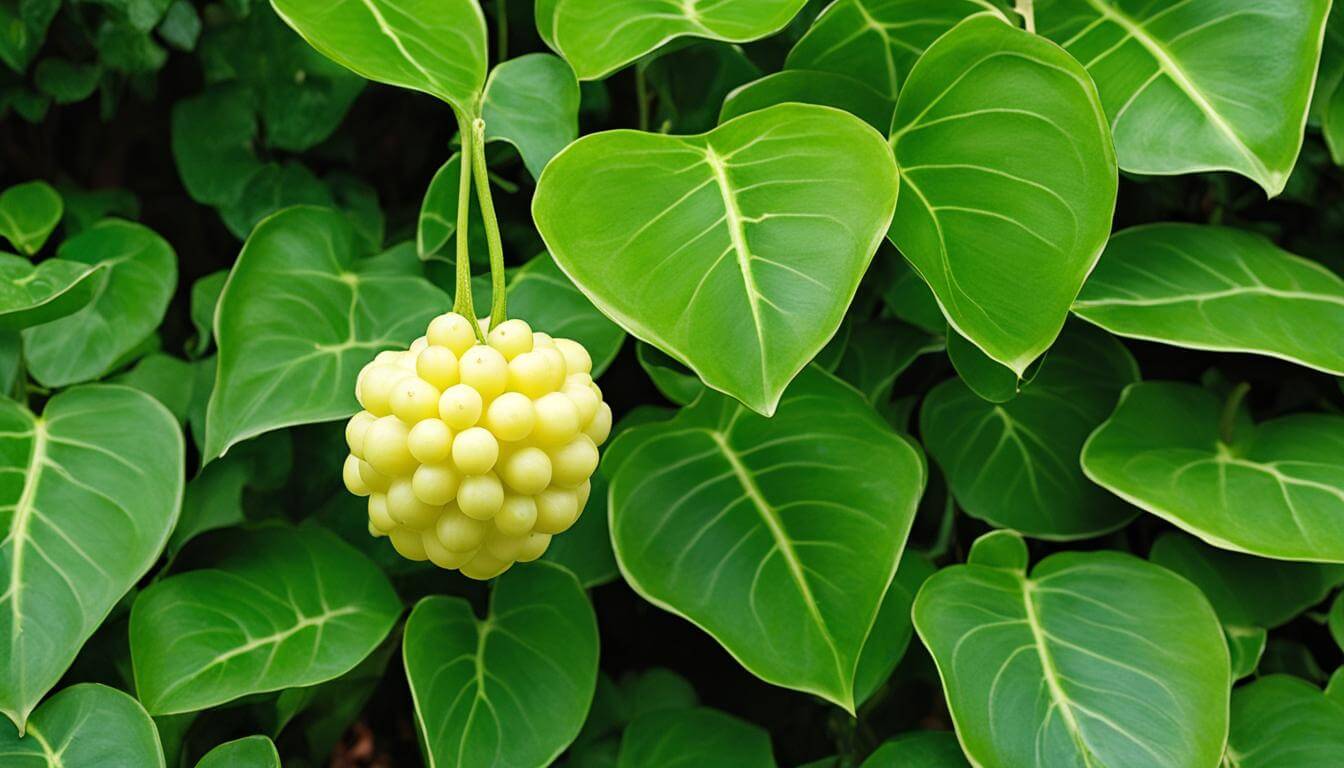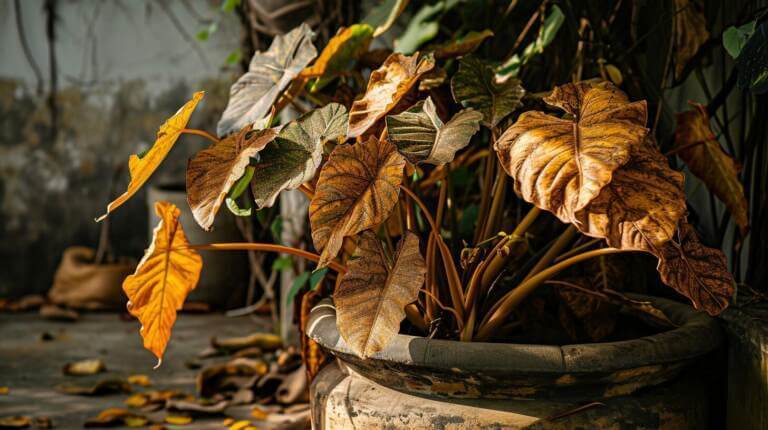As a lover of exotic fruits and striking houseplants, I’m captivated by the Swiss cheese plant and its tantalizing fruit. Known scientifically as Monstera deliciosa, this tropical plant is cherished for its unusual leaves adorned with fenestrations, which grant it an unmistakable presence in any space. But what I find most intriguing is the edible Monstera deliciosa fruit, an enticing delicacy that combines the flavors of banana and pineapple into a singular, flavorful experience.
In this article, we will delve deep into the world of Monstera deliciosa fruit and learn about its distinctive appearance, formation, and taste. We’ll also explore what it takes to yield ripe fruit from this native species to Central America, commonly known as the Mexican breadfruit plant or fruit salad plant. A word of caution before we begin: consuming unripe Monstera deliciosa fruit can cause mouth and throat irritation due to the presence of calcium oxalate crystals. So, it’s critical to know how to identify a ripe fruit before indulging in this tropical treat.
Key Takeaways
- Swiss cheese plants (Monstera deliciosa) are renowned for their exotic fruits and striking appearance.
- Native to Central America, Monstera deliciosa fruits boast a delicious blend of banana and pineapple flavors.
- Fruits take on a unique appearance, with green hexagonal scales that peel away to reveal edible creamy flesh.
- Proper conditions and care are essential for fruit growth, especially in indoor environments.
- Be mindful of calcium oxalate crystals in unripe Monstera fruits, which can cause irritation when consumed.
Unveiling the Mystery: What Does Swiss Cheese Plant Fruit Look Like?
The appearance of Monstera deliciosa fruit, commonly known as the Swiss cheese plant fruit, is an intriguing enigma. The fruit can grow up to 12 inches in length, bearing a striking resemblance to a green ear of corn adorned with unique green hexagonal scales. However, unlike corn, these fascinating scales serve to protect a delectable secret: a sumptuous, edible creamy flesh hidden within.
As the unripe Monstera deliciosa fruit ripens, the green scales begin to lift and unveil the rich, luscious pulp underneath. This process starts at the base of the fruit, gradually revealing the appetizing interior. When the fruit reaches full maturity, the scales should detach effortlessly—any resistance indicates that further ripening is necessary.
A delightful scent is also a reliable indicator of the ripe fruit appearance. To hasten the ripening process, you may store the unripe fruit in a warm environment such as a paper bag. This simple trick can help expedite the natural process, allowing you to enjoy the Monstera fruit sooner.
From Bloom to Edible Delight: The Swiss Cheese Plant’s Fruit Formation
To enjoy the fruits of the Monstera Deliciosa plant, a few crucial factors need consideration, including growing conditions, ripeness indicators, and plant care. Let’s delve into the details of each aspect, ensuring the best chances of fruit development in a home environment.
The Ideal Conditions for Monstera Deliciosa to Produce Fruit
Tropical areas rich in warm climates and high humidity are the natural homes of Monstera Deliciosa, providing the optimal environment for fruit formation. The plant thrives when given adequate space for its aerial roots to scale and search for water.
One solution for reproducing these growing conditions in non-tropical regions is to use a greenhouse. Providing the monstera with a humid, spacious, and warm environment enhances its chances of fruiting. This method emulates the monstera deliciosa growing conditions and monstera flowering conditions found in zones with a tropical climate.
Timing is Key: Recognizing When the Fruit is Ready to Eat
Patience is essential when it comes to enjoying the ripe monstera deliciosa fruit. The ripening process can take over a year from flowering. Determining when the fruit is ripe and ready to eat is crucial to avoid consuming unripe and potentially harmful parts of the fruit.
Ripeness indicators include the green hexagonal scales beginning to lift, revealing the creamy white flesh underneath. An inviting aroma also accompanies this transformation. If the scales don’t detach easily, it’s a sign that the fruit needs more time to ripen.
The Significant Role of Proper Care in Fruit Development
Proper care plays a crucial role in the monstera fruit formation and overall growth of the Monstera Deliciosa plant. To successfully grow monstera deliciosa fruits at home, it’s vital to recreate the tropical plant’s native habitat as closely as possible, including ample space, high humidity levels, and a consistently warm environment.
While indoor cultivation might inhibit flowering and fruition, adherence to these guidelines will increase the likelihood of successful growth, eventually leading to the formation of sumptuous fruits.
Tempting and Tropical: The Flavor Profile of Monstera Deliciosa Fruit
The flavor of monstera deliciosa fruit is a captivating array of tropical fruit flavors, most notably reminiscent of banana and pineapple. Every bite of the ripe fruit delivers an indulgent taste experience, transporting your palate to exotic destinations.
Some tasters have discerned subtle nuances of strawberry or even passion fruit alongside the predominant banana and pineapple notes. The intricate and vibrant flavor profile has led to the inclusion of monstera deliciosa fruit in various monstera-based desserts and dishes, or simply to be enjoyed as a standalone delicacy.
Monstera deliciosa fruit is a symphony of tropical flavors, making it a true culinary gem that shines both as a delightful snack and in sophisticated dessert recipes.
Not only is the monstera deliciosa fruit taste a sensory delight, but it also offers some impressive nutritional benefits. The ripe fruit is packed with potassium and vitamin C, enhancing its appeal as a monstera delicacy. A comparison of popular tropical fruits and their vitamin C content is provided in the table below.
| Fruit | Vitamin C per 100g |
|---|---|
| Monstera Deliciosa | 20 mg |
| Pineapple | 47.8 mg |
| Banana | 8.7 mg |
| Strawberry | 58.8 mg |
| Passion Fruit | 30 mg |
Whether in elegant monstera-based desserts or as a solo treat, the captivating combination of tropical fruit flavors and valuable nutrients elevate the monstera deliciosa fruit as an exotic culinary indulgence worth savoring. So, when the opportunity arises, immerse yourself in the lush and inviting world of monstera deliciosa and experience the enchanting taste of this tropical treasure.
The Journey of Swiss Cheese Plant Fruit: From Domestic Enjoyment to Invasive Species
The Monstera deliciosa, commonly known as the Swiss cheese plant, is admired for its ornamental beauty and delectable fruit. Originating from the tropical regions of southern Mexico to Panama, it has recently become a popular houseplant worldwide. While its stunning appearance and unique flavors have enthralled gardening enthusiasts, this versatile plant has displayed an unintended dark side as well—namely, transforming into an invasive species in some parts of the world.
In regions such as Hawaii, Seychelles, and the Society Islands, the Swiss cheese plant has been introduced as an ornamental plant, only to soon begin encroaching upon native ecosystems. Its resilience and adaptability in warm climates have empowered it to proliferate with great ease; characteristics that initially made it appealing for domestic cultivation now pose a threat to the rich biodiversity of these tropical forests. As more people grow and propagate the Monstera deliciosa, understanding the potential negative effects of this lush foliage and fruit bearing plant is vital for a sustainable future.
In conclusion, the Swiss cheese plant, with its innate artistry and appealing fruit flavors, has garnered a special place in the hearts of gardeners and food aficionados alike. Although it remains a cherished addition to homes and gardens within its native Central and South America, vigilance must be exercised when introducing this exotic species to foreign ecosystems. Allowing ourselves to appreciate its unique beauty in a responsible manner will ensure that our fondness for this tropical gem does not inadvertently compromise our planet’s delicate environmental balance.
FAQ
What does Swiss Cheese Plant fruit look like?
The fruit of Monstera deliciosa resembles a green ear of corn, covered with green hexagonal scales. As the fruit ripens, the scales open to reveal the creamy, edible flesh underneath.
How can I tell if the fruit of Monstera deliciosa is ripe and safe to eat?
Ripeness is indicated when the hexagonal scales begin to detach easily from the fruit, revealing creamy-white flesh beneath. A pleasant aroma will also be present. If the scales do not come off easily, the fruit requires more time to ripen.
What are the ideal conditions for Monstera deliciosa to produce fruit?
Optimal conditions for fruit production include warm, tropical climates similar to its native regions of southern Mexico through Central America, high humidity, and plenty of space for the plant to spread its aerial roots.
What does Monstera deliciosa fruit taste like?
The fruit offers a unique flavor profile, with notes of banana and pineapple predominating. Some individuals also detect hints of strawberry or passion fruit. The ripe fruit is rich in potassium and vitamin C, adding a nutritious aspect to the taste experience.
Is Monstera deliciosa considered an invasive species?
Yes, Monstera deliciosa has become an invasive species in some regions outside of its native habitat, such as Hawaii, Seychelles, and the Society Islands. Its adaptability and rapid growth make it a formidable competitor in these ecosystems.
How can I encourage my Monstera deliciosa to bear fruit?
Proper care and mimicking the plant’s native habitat are crucial for encouraging fruit development. Provide ample space, high humidity, and a warm environment to improve the chances of successful growth and fruit production.







